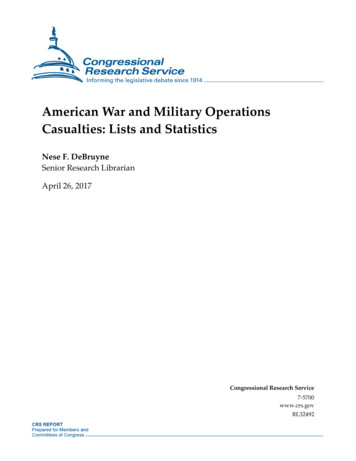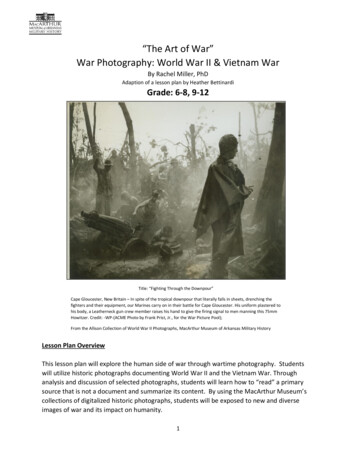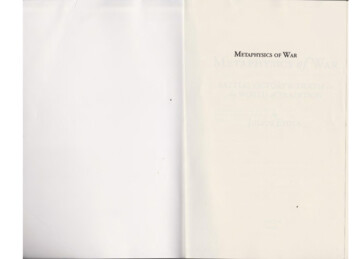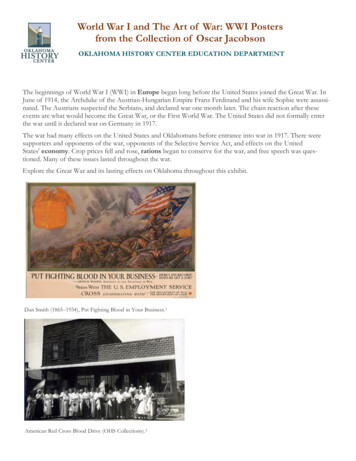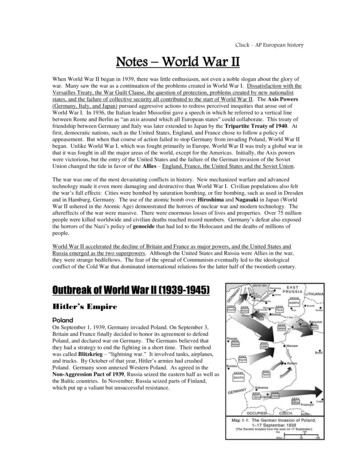
Transcription
"Opinions, conclusions, and recommendations expressed or implied within are solely those of theauthor(s) and do not necessarily represent the views of the Air University, the United States Air Force,the Department of Defense, or any other US government agency."Lessons Learned from 2017: War with Russia for the Command andControl Community in a Baltic Sea Invasion Scenario.Author-Captain Beth “Hulk” Klingele2017: War with Russia is a “future history” set after the shocking real-world invasion ofCrimea by Russia in 2014. Since the end of WWII, direct State-on-State war has been virtuallyunthinkable in modern Europe and much of the policy in the early 2010s was rooted in thisassumption. The invasion of Crimea and then eastern Ukraine in defiance of the 1994 BudapestMemorandum and Russia’s continued aggression in the region has shown a fundamental shiftin Russian intentions towards the West, tearing away the façade of assumed peace and stabilitythat Europe had enjoyed for nearly 70 years. General Sir Richard Shirreff, author and formerDeputy Supreme Allied Commander Europe, brings his considerable experience as a top Britishmilitary officer at the head of the North Atlantic Treaty Organization (NATO) leadership todeliver a chilling scenario where Russia isn’t content with annexing Crimea alone, but makesgood on its 2014 promise to unite all ethnic Russian speakers under the banner of MotherRussia (Kendall, Shirreff preface).Largely aimed as a wake-up call for NATO governmental policy makers and strategicthinkers, War with Russia delivers valuable insight for military professionals of all ranks and thegeneral public alike who are seeking to gain more knowledge about the politics and challengessurrounding the Baltic States. Shirreff breaks down the policies and government actions ofNATO leading up to the Crimean invasion and discusses how these actions-or inactions-maybring NATO closer to an armed confrontation where nuclear escalation becomes a very realpossibility. This review seeks to present the four most relevant concepts and issues presentedthat command and control planners can take into consideration and learn from if they are facedwith a Russian invasion of the Baltic States like the one detailed in this book.The first key problem Shirreff presents is knowing when to confront covert Russianaction when the Russians have become so good at challenging other Great Powers in such away so as not to trigger an armed conflict. Russia is adept at using social media and propagandaas informational warfare campaigns to infiltrate the psyche of targeted populations in order tocreate instability and subversion of the national government (Giles). This can be effectivelycombined with advanced cyberattacks, attacks by proxy agents, and direct infiltration ofextremist political groups within a country’s populace to create a seemingly valid reason forRussian intervention that paints them in the role of savior instead of would-be conqueror.Indeed, it is this very scenario that creates justifiable cause for the Russians to invadethe Baltic States in War with Russia. Claiming to be protecting Russian compatriots who arebeing attacked and oppressed, Russia executes a carefully and expertly planned operation thatcreates significant political and social divide between ethnic Russian speakers and the Balts.
"Opinions, conclusions, and recommendations expressed or implied within are solely those of theauthor(s) and do not necessarily represent the views of the Air University, the United States Air Force,the Department of Defense, or any other US government agency."This leads ethnic Russians within the Baltics to make public requests begging for Russianintervention, a call which Russia is prompt to respond to. Similar tactics have been used tojustify the invasion of Georgia in 2008 and eastern Ukraine in 2014. Shirreff points out thatRussia will continue to use these tactics against the Eastern Bloc States as long as Russia feelsNATO or the West will do nothing significant against them.The challenge, then, is for command and control planners to recognize when this ishappening. NATO must be prepared to create a strong deterrence to aggressive actions by theRussians while providing active support, reassurance, moderation, and defense to the BalticStates to prevent them from needing to seek the support of the Russian government. Thisrequires nuanced and redefined criteria for when an “attack” has been conducted against aNATO ally and what actions trigger a conflict beyond traditional warfare. Planners shouldconsider a scalable reaction with clear criteria that includes non-traditional and cyber warfarewhile allowing sufficient buffer time to employ counter actions in defense of vulnerable States.NATO will be behind the eight ball if it waits for Russia to commit conventional military forcesto counter Russian aggression.Shirreff argues passionately that NATO has failed in this duty to adequately challengeovert and covert Russian aggression up to this point. Shirreff presents his second key problemconcerning this issue: NATO members’ complacency towards European defense policy,particularly those policies starting in 2010. He is especially critical of the United Kingdom whomhe once served and who has historically been considered one of the most powerful militaryforces in Europe. The UK 2010 Defense Review placed a premium on creating a “lean” forcethat utilized only 2% of the national GDP which effectively cut 20,000 regular army troops,reduced the UK’s naval support fleet, and scrapped its maritime aircraft capabilities leading upto 2014. The Prime Minister further made statements in 2016 that “Britain should avoidsending armies to fight” and implied that the Army would be primarily tasked for humanitarianmissions (Shirreff, Wyatt).The United States has similarly taken advantage of European peace and began lookingincreasingly towards other parts of the world, conducting an “Asia-Pacific” pivot in 2011 underthe Obama administration to challenge North Korean actions and grow economic partnershipsin the region (Reininger et al.). The US also removed all of its tanks from Germany in 2013 forthe first time since WWII and renewed its focus in the Middle East to combat the uprise of theIslamic State in 2014. The US has continued to drawdown the number of troops stationed inEurope, especially in Germany, under the Trump administration (Gould).This reduction in military presence by the US combined with previous comments frompresidential candidate Donald Trump on the conditionality of American support to NATO alliesin 2016 (Sanger) has, in Shirreff’s words, “undermined the notion of NATO’s founding principleof collective defense [because] NATO is totally dependent on strong US leadership and peace inEurope will only be maintained if there is absolute certainty that the US will always be there to
"Opinions, conclusions, and recommendations expressed or implied within are solely those of theauthor(s) and do not necessarily represent the views of the Air University, the United States Air Force,the Department of Defense, or any other US government agency."defend its allies.” He further warns that, “Trump’s comments will embolden the [Russian]President and make the nightmare scenario in this book more likely.”Politically insensitive comments and public military drawdown can set a dangerousprecedent in a high-speed technological world where the Russians can analyze and act onperceived weakness in real-time and should be handled carefully. Planners and policy makersmust actively monitor and shape NATO’s world image in the face of such threats to preventRussia from taking attacks of opportunity on a weakened NATO alliance. Russia is unlikely towait and see if NATO members are able to renew and strengthen their military forces prior toattack for the simple reason that it would not suit their interests to do so. It is the perception ofNATO’s weakness combined with a steady decrease in military capability that spurs Russia intotaking the initiative in Shirreff’s scenario. They swiftly invade the Baltic States to capitalize onthe opportunity before NATO has the chance to react and generate sufficient conventionalforces to counter them.This leads to the third key problem Shirreff presents: the continued growth anddevelopment of conventional military forces. It is seductive to policy makers and voters whoare tired of decades of fighting to reduce military forces and development to conservespending, but avoiding nuclear escalation requires both a strong conventional military andnuclear deterrence when facing a nuclear State. One does not work without the other andstrength must be met with strength on both fronts. If NATO becomes less reliant onconventional military forces, then it will have to become more reliant on nuclear deterrencewhich makes the option of nuclear retaliation in the face of unacceptable end states morelikely. This has the potential to push NATO closer to a nuclear conflict rather than away fromone. Lack of conventional troops and war material ready to deploy is a major driver in Shirreff’sinvasion scenario. Post invasion, NATO is left scrambling to organize a reactionary force whilefacing the daunting prospect of a counter invasion to liberate the Baltics against an advancedRussian threat that is willing to protect its newly acquired States with tactical nukes (theRussian version of “nuclear de-escalation”) (Shirreff).Shirreff would be heartened to know that, since the War with Russia was published,NATO has succeeded in deploying four rotating multinational battalions to support the BalticStates and Poland under the guidance of the US, UK, Germany, and Canada as agreed in the2016 Warsaw Summit (“NATO’s presence”). This bolsters the defense of the Baltics and servesto show conviction and resolve on behalf of the alliance towards their defense. However, theunderlying issue remains the same. NATO must continue to support and advance itsconventional military forces to keep pace with the rapid military development of Russia, for“once you cut capability, it requires a superhuman effort to regenerate it” (Shirreff preface).Russia has the geographical and temporal advantage to launch its military forces directly acrossits border and has put very capable military systems in place along that border and in Russianheld Kaliningrad. To that effect, NATO forces will have to contend with a sophisticated
"Opinions, conclusions, and recommendations expressed or implied within are solely those of theauthor(s) and do not necessarily represent the views of the Air University, the United States Air Force,the Department of Defense, or any other US government agency."integrated air defense system (IADS), advanced fighters, tactical nuclear defense, and Russia’sinherent ability to field reinforcements directly from its backyard (Conversino).NATO must continue to develop and improve its conventional forces to keep up withRussian advances. It also must remain relatively flexible and willing to move war material andpersonnel quickly due to NATOs geographic disadvantage and dependance on other States tohost NATO forces. Russia’s proximity will allow it to field forces faster than NATO can with theexception of any forces already preposition within the Baltic States. This is especially worrisomedue to the increase in Russian snap exercises hosting upwards of 30-40 thousand troops alongBaltic borders since 2015 (Shirreff, Stiburg 37-39). For some NATO members who aresignificantly geographically separated from the Baltics, this will require particular considerationin manning and material that has been promised towards NATO defense. Simply stationingequipment around Europe and storing it will not be enough. Any war material that is“mothballed” must also be supported with training, manning, logistics, and a clear structure ofcommand and control authority (which is not an insignificant challenge in a multi-nationalalliance) if it is to be counted towards military capability. Otherwise, planners can count on ittaking a significant amount of time to bring up to combat readiness (Shirreff).However, no amount of military equipment will win a war if it cannot get to thebattlefield and this leads to Shirreff’s fourth key problem: cultivating both political relationshipsand the political will to commit military forces in a united effort. In the book, the North AtlanticCouncil (NAC) in NATO took 13 days from the first indications of conflict to declare Article 5 (anagreement to collectively go to war) in defense of the Baltic States. NATO was unable to launcha counter attack until 47 days later due to political and conventional force generation issues.This was largely due to a number of political hurdles that greatly reduced their ability to react intime to prevent the Russian invasion.The largest delay came from the requirement of a unanimous vote of the NAC to declareArticle 5, which becomes a risk when quick reaction decisions are needed. This unanimous votebecomes more difficult to secure with an increasing number of members in NATO which hasgrown from 12 nations to 30 in the years between 1949 and 2020 (“Enlargement”). Newmembers generally bring in a rich diversity of heritage and ideologies that strengthen thealliance. However, some countries in the fictional scenario had significant financial and religiousties to Russia that made them rigidly disinclined to agree to conflict with Russia despite thewarning signs. Command and control planners should work closely with their diplomaticpartners to put special effort towards building relations with these nations, but planners mustalso take this probable delay into consideration when planning operational contingencies andshould be prepared for unilateral or bilateral action to protect national interests.Once a decision to provide military defense of the Baltics was made, NATO experiencedadditional delays moving their forces and war material across the plethora of borders inEurope. Continued conflict in the Middle East has generated a mass immigration into Europe by
"Opinions, conclusions, and recommendations expressed or implied within are solely those of theauthor(s) and do not necessarily represent the views of the Air University, the United States Air Force,the Department of Defense, or any other US government agency."refugees seeking to escape the violence. This has resulted in stricter border protocols that hastied up many nations’ fighting forces to control the influx of people and prevent the rise interrorist acts in Europe (Shirreff). Command and control planners and policy makers shouldwork to ensure that special license is given to these forces to move rapidly across nationalborders (especially States within the alliance) to ensure that reinforcements can be fielded intime to make a useful contribution in deterrence operations or armed conflict.Shirreff’s nightmarish scenario ends in a major multinational operation that is savedlargely due to an unusually effective cyber solution that provides Shirreff with his deus exmachina to end the scenario with a quick, decisive, and largely bloodless victory for the NATOalliance. A fictional computer virus is introduced into the Russian computer system by theBritish to bypass all Russian command and control system redundancies to completely shutdown Russia’s ability to control their surface-to-air missile (SAM) systems or launch an effectivecounterair attack. NATO fighters and bombers are able to overfly the Baltic States with nearimpunity. Special forces from the UK and the US simultaneously overtake Kaliningrad’s tacticalnuke sites and are able to hold Russia hostage with them to force a resolution in NATO’s favor.And, naturally, the strapping young British office that plays one of the main protagonists getsthe girl.It is unlikely for a real Baltic invasion scenario to end so cleanly for NATO forces and thisfantastical conclusion should not take away from the key problems Shirreff presents to hisreaders. Policies based on assumptions of peace will not hold water and NATO must continue todeploy troops and war material strategically and in appropriate strength in anticipation ofpossible Russian attacks, recognizing that Russian attacks are no longer as easy to spot as theywere prior to the invention of the internet and social media. Russia will continue to developnon-traditional warfare techniques to supplement its rapid development of advancedconventional forces and NATO States must be prepared to meet them strength for strength inboth conventional and nuclear war capabilities. Lastly, political relationships, the essentialingredient to the development of a resolute NATO body, will be crucial for the proper defenseof the Baltic States. Only cooperation and a willingness to act in unity will allow NATO toeffectively combat an enemy that isn’t hampered by the need for multinational consensus.The command and control community is uniquely positioned to provide such insight andactionable solutions to policy makers and should make every effort to do so, thoughtfully takinginto consideration the lessons learned from War with Russia. This “future history”is a warning that NATO faces considerable challenges to deterring Russian aggression, but italso provides hope that all is not lost and that a few good men and women can make adifference if they put in the effort to do so.
"Opinions, conclusions, and recommendations expressed or implied within are solely those of theauthor(s) and do not necessarily represent the views of the Air University, the United States Air Force,the Department of Defense, or any other US government agency."References“Boosting NATO’s presence in the east and southeast.” North Atlantic Treaty Organization(NATO), 20 Oct. 2020, https://www.nato.int/cps/en/natohq/topics 136388.htm.Accessed 08 December 2020. Accessed 11 Dec. 2020.Conversino, Mark. “Dr Conversino.” Air University, 31 July 2020. Video Lecture. Accessed 11Dec. 2020.“Enlargement.” North Atlantic Treaty Organization (NATO), 05 May 2020,https://www.nato.int/cps/en/natolive/topics 49212.htm. Accessed 13 Dec. 2020.Giles, Keir. “Russia’s ‘New’ Tools for Confronting the West. Continuity and Innovation inMoscow’s Exercise of Power.” Russian and Eurasia Programme, Mar. . Accessed 08 Dec. 2020.Gould, Joe., and Sebastian Sprenger. “Trump’s troop drawdown from Germany will take ‘years,’says Inhofe.” Defense News, 24 July rs-says-inhofe/. Accessed 08 Dec. 2020.Kendall, Bridget. “Crimea crisis: Russian President Putin's speech annotated.” BBC News, 19Mar. 2014, https://www.bbc.com/news/world-europe-26652058. Accessed 08 Dec. 2020.Reininger, Brent and Sarah Stewart et al. “Assessing the Obama Administration’s Pivot to Asia.”University of Washington-Henry M. Jackson School of International Studies, rks/handle/1773/40759. Accessed 08 Dec.2020.Sanger, David E. and Maggie Haberman. “Donald Trump Sets Conditions for Defending NATOAllies Against Attack.” The New York Times, 20 July s/donald-trump-issues.html. Accessed08 Dec. 2020.Shirreff, General Sir Richard. 2017 War with Russia. Kindle ed. Coronet Books, 2016.Stiberg, Espen. “Russian Snap Military Exercise in March of 2015; What Implications Did ThisExercise Have?” U.S. Army Command and General Staff College, 9547.pdf. Accessed 11 Dec 2020html.Accessed 08 Dec. 2020.Wyatt, Caroline. “Has Britain’s defense budget been cut too much?” BBC News, 24 Feb. 2014,https://www.bbc.com/news/uk-
"Opinions, conclusions, and recommendations expressed or implied within are solely those of theauthor(s) and do not necessarily represent the views of the Air University, the United States Air Force,the Department of Defense, or any other US government agency."26271018#: :text 0number%20of%20reservists. Accessed 13 Dec. 2020.
Lessons Learned from 2017: War with Russia for the Command and Control Community in a Baltic Sea Invasion Scenario. Author-Captain Beth "Hulk" Klingele 2017: War with Russia is a "future history" set after the shocking real-world invasion of Crimea by Russia in 2014. Since the end of WWII, direct State-on-State war has been virtually



